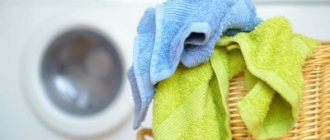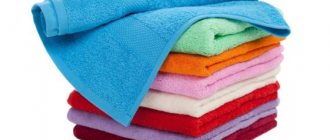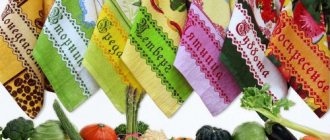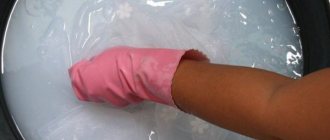If the corridor begins with a hanger, then the kitchen begins with a towel. The product is multifunctional: it is convenient for wiping hands, handling hot dishes, and removing greasy stains on a countertop or cup. Such intensive use leads to severe contamination of the fabric, which cannot be removed by regular washing. That is why every housewife will need useful tips on how to bleach kitchen towels at home using improvised means. Let's look at the most popular and well-proven methods - from well-known to very unexpected.
How to prevent severe pollution
As they say, it is clean where there is no litter. This proverb is quite applicable to textiles. Preventing severe contamination is much easier than removing it. To make your kitchen towels less dirty, you need to:
- use waffle, linen or cotton fabrics - terry fabrics get more dirty and wash less well;
- wipe hands, dishes and cover pies with cloth napkins, and use non-woven materials for the table;
- wash more often to avoid dirt being absorbed into the fabric structure;
- use white textiles: dirt is more visible on it;
- Wash dishcloths separately from other laundry.
The problem is easier to prevent
Instead of looking for ways to effectively bleach a kitchen towel with old stains, you can try to avoid the need for such drastic measures.
If you take care of the cleanliness of the towels in advance, radical measures will not be required.
We have put together a list of recommendations for you that will help you keep your towels clean without much effort.:
- First of all, keep your towels in a place away from sources of pollution. Hooks on the wall are not a tribute to Soviet fashion, but a truly convenient way to keep textiles relatively clean.
- Think about how you use textiles . A white towel is not the best choice for wiping up spilled meat juices on the table or catching drips from the floor. For these purposes, it is better to get sponges and microfiber cloths.
- Is the towel dirty? This is a reason for urgent laundry. Don’t wait for the stain to set in: it’s easier to wash it fresh than to remove it for a long time.
- It is easier to bleach a white waffle towel than a terry towel. On the latter, dirt accumulates much faster. Therefore, give preference to the first option.
- After washing, be sure to iron the towel. This way the dirt will stick to it less. Oddly enough, this method really works.
As you can see, there is nothing particularly complicated in the recommendations for caring for towels. But what to do if some of them have persistent stains or the fabric has acquired an unpleasant shade? Let's figure it out now!
Soak
Bleaching will be more effective if the textiles are soaked before washing.
The following substances will help get rid of stains.
- Mustard powder. It requires 50 g per half liter of boiling water. The resulting mixture is diluted in hot water, the products are soaked overnight and then rinsed.
- Laundry soap. For 3 liters of warm water, half a block grated is enough. Grease stains should disappear within 5 hours, after which the fabrics should be washed.
- Turpentine. For 1 liter, take 1 tablespoon, leave for 8 hours, then rinse.
- Baking soda. Dilute 2-3 tablespoons in 1 liter of water, add a little essential oil. Soaking time – 3 hours.
- Hydrogen peroxide. A small amount is applied to the stain or dissolved in water. Wash after 40 minutes.
- Dishwashing liquid. With it you can soak towels directly in the sink for 1.5–2 hours.
- Ammonia . Dilute 5 tablespoons and 10 tablespoons of soda in 5 liters of warm water. In this case, it is enough to soak for 5 hours.
- Boric acid. It is used only for coarse waffle or cotton towels, as there is a danger of damaging lightweight fabrics. Two tablespoons diluted in five liters of water are designed to remove stains in 2 hours. Old stains will require repeating the procedure. Do not add bleach to the boric acid solution, otherwise streaks may appear.
Table vinegar
If a towel has been left for a long time, germs accumulate on it, causing a terrible musty smell. Even washing doesn’t always get rid of it, but vinegar will help. It creates an acidic environment in which microorganisms cannot survive:
- Pour 1.5 liters of very warm water into a basin.
- Add a faceted glass of vinegar. Take regular tableware, but not essence!
- Throw a towel in there to soak for 12 minutes.
- Then remove and rinse thoroughly in running water.
The smell will disappear, and it will be easier to wash kitchen towels from old greasy stains, since vinegar partially dissolves them.
Boiling
Today, this method is rarely used, but meanwhile, in addition to bleaching, boiling disinfects laundry, which is important in the kitchen.
My grandmother, who does not have a washing machine, almost never washes by hand: she first soaks all white fabrics, then boils them and rinses them. The effect is wonderful.
For boiling, choose enameled or stainless steel dishes with a volume of 5 liters or more, but the larger the better. The linen is removed with wooden tongs. Heavy stains must be removed before boiling, otherwise the stains will penetrate even deeper into the fabric.
Classic boiling lasts an hour or more, and then the laundry is infused for up to 12 hours.
Now remember how you can remove stains faster and without harm to the body.
- Just a few crystals of potassium permanganate added to the soap solution (20 g of soap shavings per 1 liter of water) will reduce the boiling time to half an hour.
- Silicate glue also helps remove stains faster. It is placed in a soap solution at the rate of 3 tablespoons per 10 liters of water.
- With soda (it is better to use soda ash) you can boil for only 10–15 minutes. A few tablespoons are added to the solution of powder or soap. Afterwards, the water is allowed to cool, and then the laundry is rinsed.
Zelenka
Brilliant green is a good dye that can be used to hide faded yellowness. To do this, wash the towel in the washing machine as usual, and then prepare the bleaching medium:
- Dissolve 5-8 drops of brilliant green in 4 liters of water.
- Submerge the towel there for 90 minutes.
- Wash it in the washing machine again.
The yellowness will be replaced by white with a barely noticeable green tint. By the way, bluing works the same way.
Bleaching in boiling water
If you don’t have the time or desire to boil, just bring the water to a boil and let it cool.
The following components will help remove stains and add whiteness.
Vegetable oil softens old stains well . 5 liters of water are heated to 100 degrees, add 2.5 tablespoons of oil, half a spoon of powder and 1 spoon of any bleach. After 12 hours, wash in a convenient way.
There is also this recipe: 20 ml of oil, 20 ml of Bos bleach, 50 ml of washing powder and 30 g of soda per 10-liter bucket of boiling water. A dirty cloth is placed in the water brought to a boil, after which the stove is turned off and the water is allowed to cool to room temperature.
Baking soda is also often used for bleaching . It can enhance the effect of vegetable oil by taking 1 tablespoon of oil, soda, bleach and powder per liter of water. The laundry is also left for 8–12 hours.
Another variation of the recipe is equal parts powder, soda and vinegar (30 g per 10 liters of boiling water) to dissolve stains for 8 hours, followed by machine washing at 70 degrees.
Hydrogen peroxide will deal with stains much faster. In 6 liters of water heated to 70 degrees, dissolve 2 tablespoons of peroxide and 1 spoon of ammonia. 20 minutes after soaking, rinse the laundry thoroughly.
Mustard powder fights dirt and grease well . Dissolve 5 tablespoons in 5 liters of hot water, let the solution brew and soak the towels for 5 hours.
To make stains come off easier, add some salt to the soaking (1 tablespoon per liter). Towels are placed in the solution for 5-6 hours, then washed in the machine. Also, salt at the rate of 1 tablespoon per liter of water is added when bleaching with peroxide and powder.
Review of store products
A product for bleaching kitchen towels at home can be seen on the shelves of every hardware store. This is an affordable way to experiment with kitchen textiles at home.
- White. This product is not expensive and is suitable for most types of fabrics. The main disadvantage of the product is the smell of chlorine, which will remain on the product. After use, it is necessary to rinse the fabric with conditioner as thoroughly as possible and wash the textiles additionally. You must strictly follow the instructions on the package, otherwise the fabric can easily be damaged. Boiling with Whiteness is not recommended, but is possible.
- Optical brighteners. They do not wash out stains at home, but hide them, since they contain dyes. If you start washing with regular washing powder after this product, the kitchen towel will turn gray, that is, it will return to its original appearance - this is the main drawback. The average cost is three hundred rubles.
- Oxygen bleaches. They contain sodium percarbonate, a safe substance. When it comes into contact with water, it separates into soda and oxygen. The bubbles push dirt out of the fibers, that is, this is a kind of washing. If optical impurities are added to the product, a whitish tint will most likely appear. On average it costs about five hundred rubles.
- Amway. Works great even on stubborn, old stains. The average cost is five hundred rubles.
In order not to have to worry about bleaching towels for kitchen use at home, it is worth preventing the appearance of old, stubborn stains. It is recommended to wash the product once every three days.
The article has been verified by the editors
Whitening in the microwave
This bleaching method is an express version of boiling and takes only 3-5 minutes.
The towels are moistened with water, rubbed with laundry soap, packed in a bag (no more than 3 pieces), but not tied, and placed in a microwave oven set to medium power. Then they wash it in the machine - the sooner the better.
In the same way, it is easy to bleach all cotton fabrics without a pattern.
Colored fabrics can be cleaned in the same way, but without heating them in the microwave: they are left in a bag overnight.
Machine washable
Recommendations for machine washing towels are general.
- White and colored napkins are washed separately.
- Pre-washing will help remove stains.
- For colored fabrics, it is better to use oxygen bleach.
- White laundry can be washed well with baking soda (it can be poured both into the powder compartment and into the drum of the machine).
- To ensure that stains are removed, you need to wash with hot (70 degrees and above) water.
- The conditioner will perfectly refresh your laundry.
Recommendations for caring for terry towels
I would also like to say something about terry towels. After repeated use, they not only become dirty, but also hard. This happens because dirt accumulates in the loops, and during washing, particles of detergent also accumulate. It is more difficult to care for such fabric than smooth fabric. But if you follow simple rules, towels will last longer.
- Terry does not like either excessive dryness or high humidity. If you leave napkins wet, they may develop not only an unpleasant odor, but also mold. Therefore, it is better to wash them immediately after soiling. And under no circumstances should you leave it in the laundry basket: lint absorbs odors very well.
- It is better to wash terry fabrics by hand without alkali and chlorine - preferably with laundry soap or bleaching shampoo (as a rule, soap contains already processed alkali). The powder will be difficult to wash out of the fibers.
- Baking soda and vinegar will help remove stubborn dirt. Baking soda is poured into the drum, and vinegar is poured into the powder hole to soften the water. It is especially important to soften the water when washing terry.
- It is advisable to wash items separately from other laundry and do not fill the drum to the limit.
- An additional rinse will help keep the fabric fresh. Terry washes well only in a large amount of water, and therefore using express washing is not recommended for it.
- Drying terry towels near heating appliances is also not worth it.
Preventive measures to keep towels clean
It is much easier to bleach any kitchen towels if certain rules are followed during their use:
- It is better to have more towels at your disposal. That is, several sets that need to be changed every 2-3 days. In such a short period of time, the stains will not have time to eat into the fabric, which makes them much easier to remove;
- After washing, kitchen towels must be ironed. It's not just the dirt-repellent effect of the iron. What will most likely work is that their presentable, smooth appearance will not be conducive to use in particularly dirty operations;
- use more disposable products, such as napkins. Of course, wiping your hands with them is not the best option, but the kitchen is full of tasks for which they are simply irreplaceable;
- do not buy terry products for the kitchen. They absorb and retain moisture well, but in a kitchen environment this is rather a drawback. Along with moisture, dirt particles accumulate on the terry fibers, which are very difficult to remove later.











